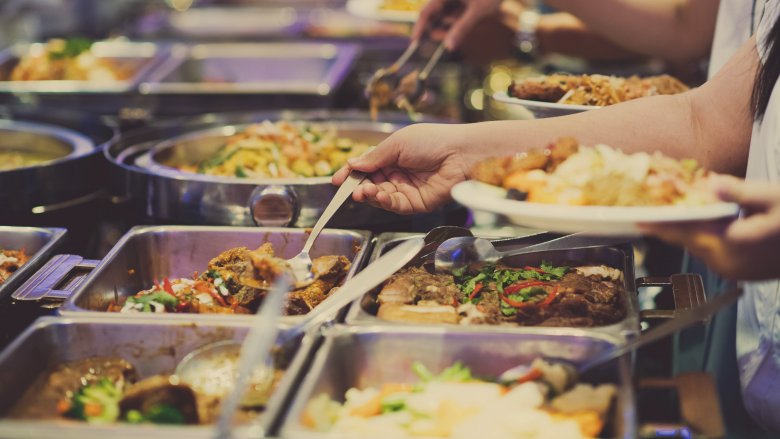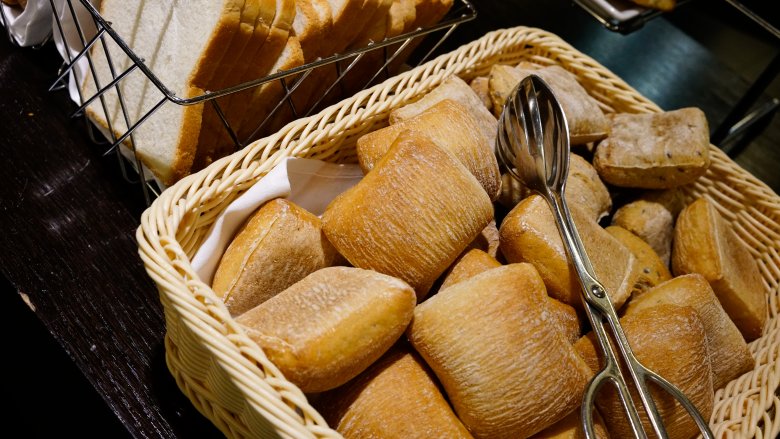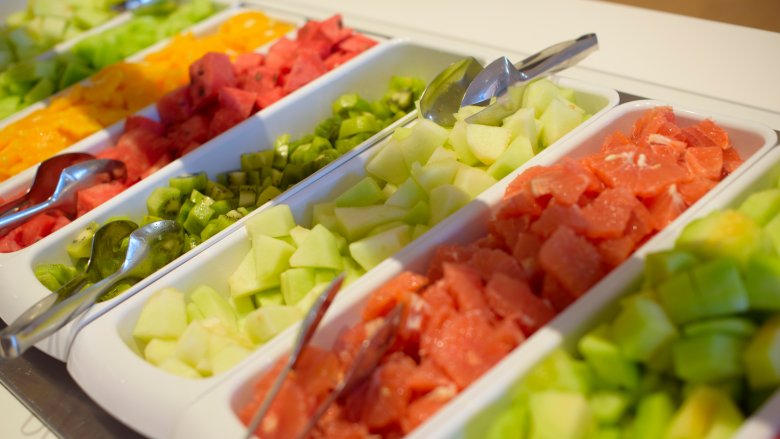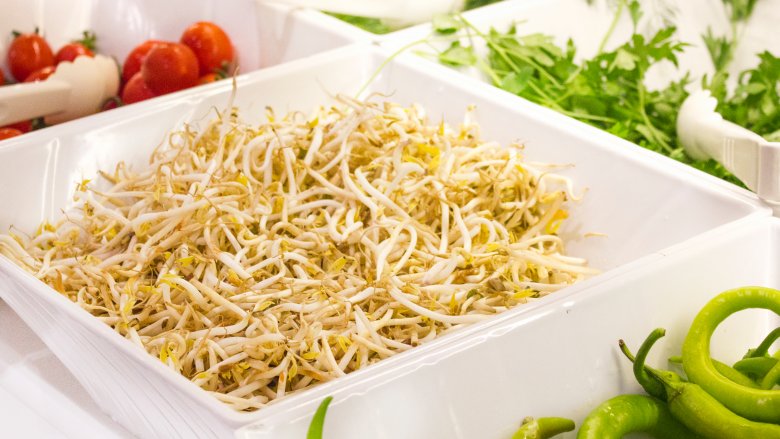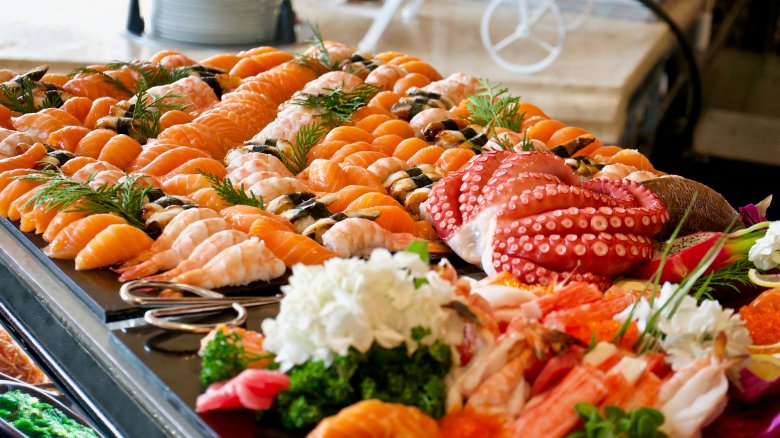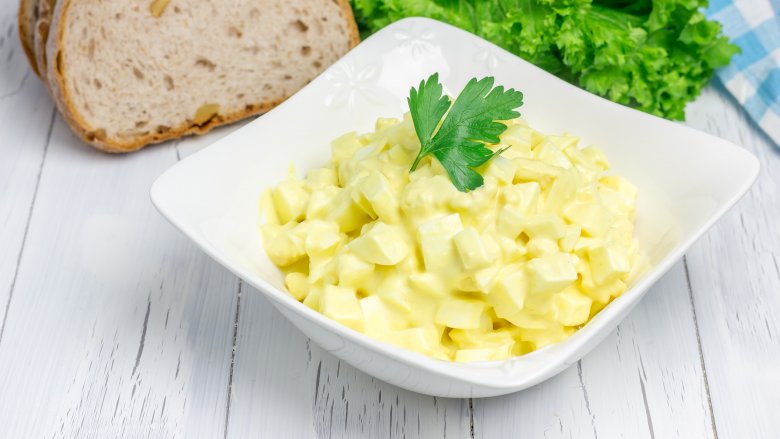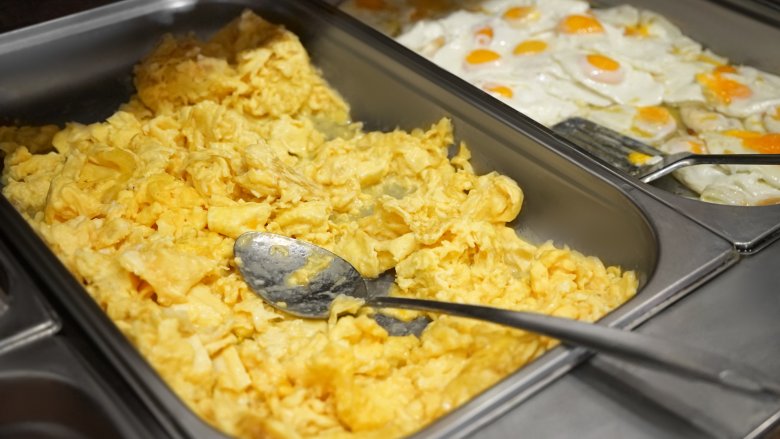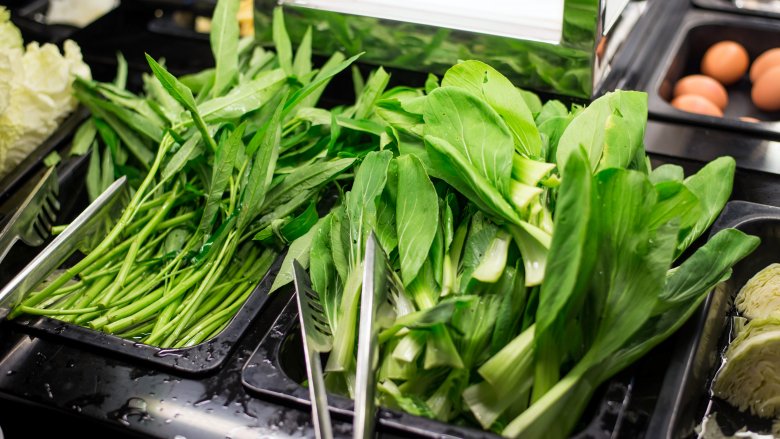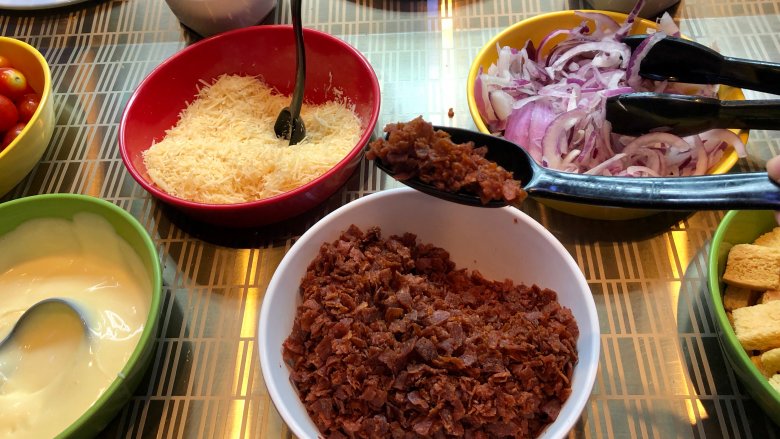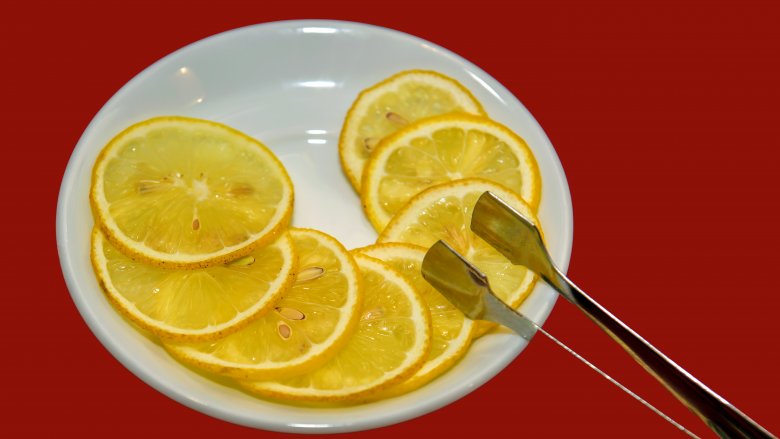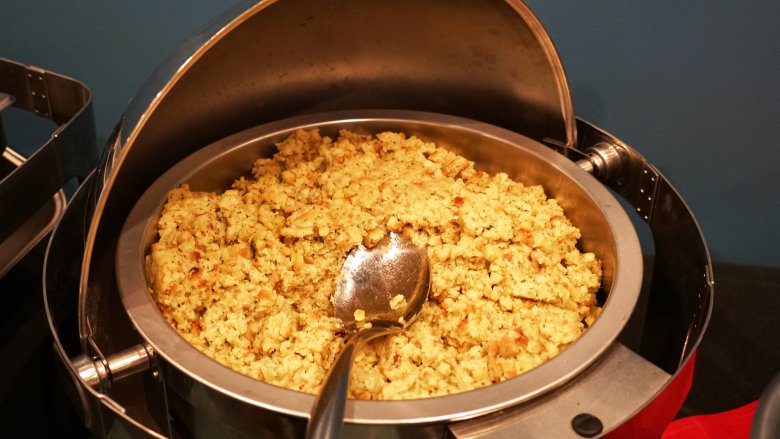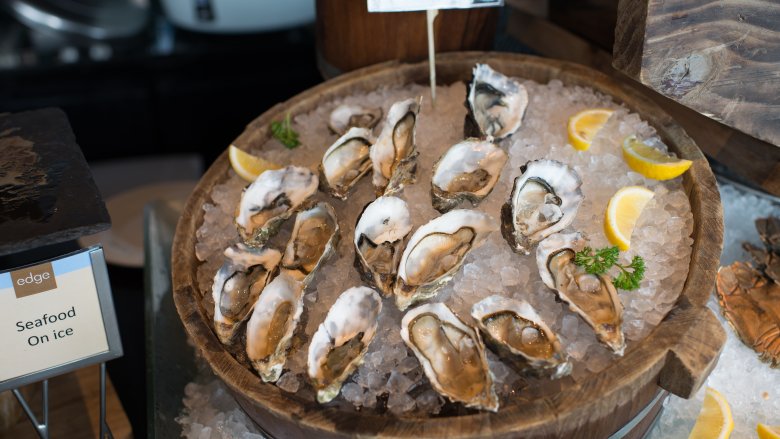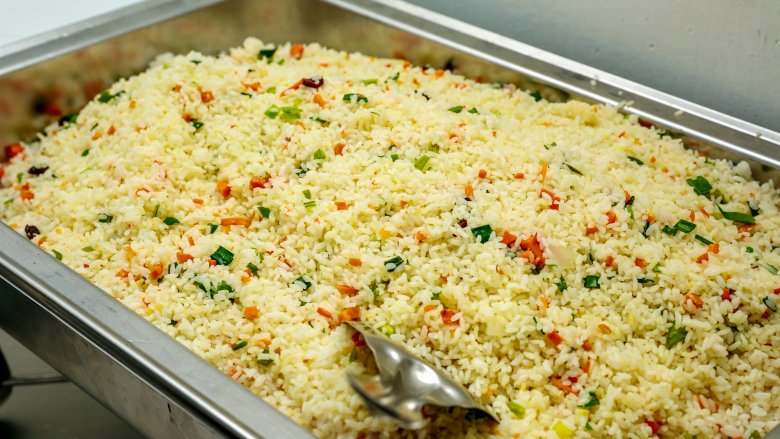Things You Should Never Touch At A Buffet
There's nothing more basic than the human need for food, and nothing taps into our animal desire for nourishment like a good, old-fashioned, all-you-can-eat buffet. It doesn't seem like anything sinister could be lurking in those warmly lit giant pans full of casseroles, meats, and salads, but unfortunately in every Garden of Eden there's at least one serpent, and in the case of the buffet, there's a few more than that.
A few of the major problems with buffets are that they pose a host of sanitation challenges, encourage overeating, aren't always a good value, and serve up dishes that are loaded with excess calories. And while only you can stop yourself from falling prey to the unending host of entrees and sides in the buffet line, there are a couple of things you can avoid to help protect yourself from foodborne illness and specific foods that'll sabotage your attempts at healthy eating.
The next time you're headed to an all-you-can-eat buffet, keep this list handy. Give it a read-through before you start loading your plate, and you'll wind up with the best of all buffet experiences: getting your money's worth, eating delicious food, and not getting sick from it.
Bread
When you pay to dine at an all-you-can-eat buffet, you want to be able to taste a little bit of everything. Unfortunately, some of those items can leave you fuller than others, leaving you with a tight belt and little room for more. One of the primary culprits? Bread.
Bread and rolls are cheap for restaurants to make, so they often load up their buffet lines with a selection of different carb-loaded items for you to sample. But why fill up on cheap, simple starches when you could be feasting on juicy prime rib, succulent roast turkey, and as much orange chicken as your plate can hold?
If you're susceptible to the call of the carbs, beware of the buffet layout. Many places set up the buffet line so that the cheap and filling items, like breads, potatoes, and creamy pasta dishes are at the front. We recommend taking a walk through the buffet before you start serving yourself so you can get a better idea of all the foods on offer, instead of letting your hunger get the best of you and winding up with a cheap plate of buttered rolls, rice, and potatoes that barely make up for the cost of entry.
Pre-cut fruit
If you're watching what you eat, the colorful, jewel-like display of cut fresh fruit at the buffet seems like the perfect solution. You can fill up on something delicious and healthy, right?
Sadly, pre-cut fruit isn't as safe a choice as it may seem. We're not talking about sugar content or anything like that. Rather, it's the way pre-cut fruit attracts bacteria that can be detrimental to your health.
Fresh fruit should be stored at a temperature of 40 degrees Fahrenheit or colder in order to stem the growth of bacteria. Any warmer, and the bacteria can rapidly grow. Since cut fruit has more surface area exposed, it is more likely that its flesh will be contaminated, especially in a buffet setting where it's often sitting in trays above ice but not in actual refrigeration. If the temperature isn't constantly being monitored, the fruit can easily slip into the "Danger Zone."
One particularly concerning fruit is cantaloupe. Its skin is a favorite breeding ground for Listeria bacteria, which can contaminate the rest of the fruit when cut. Unfortunately cantaloupe is also inexpensive and thus often found in buffet lines and in fruit salads.
If you're pregnant, it's even more important that you avoid pre-cut fruit at the buffet, as getting an infection from a bacteria-infested fruit can pose a danger to your fetus.
Sprouts
Sprouts are often considered to be one of the healthiest foods you can eat, containing a higher dose of beneficial nutrients than in their unsprouted (seed) or fully grown (plant) states. That being said, they can also be one of the most dangerous foods to eat. How is that possible?
It turns out that the reason why sprouts can be dangerous to eat is because "They grow in damp environments, and it's hard to get them thoroughly cleaned," according to Rene Ficek, an RN for Seattle Sutton's Healthy Eating.
According to the FDA, seeds and beans need a humid environment to grow, and that extra moisture can make them more susceptible to bacterial contaminants like E. coli, salmonella, and Listeria. When they're then served raw in the buffet salad bar and not cooked to a food-safe temperature, you could be in for a world of hurt.
The next time you're at the buffet and looking for a healthy option, you might be better off skipping those salad bar sprouts and opting for some cooked vegetables instead.
Sushi
The cost benefit of eating sushi at an all-you-can-eat buffet can cloud your judgment. After all, sushi can get pretty pricey, and when it's the same price as a leaden brick of macaroni and cheese over at the casserole station, why not indulge?
Well, as you may suspect, keeping a massive quantity of raw fish out on a buffet isn't exactly a great idea. Sushi needs to be kept at or lower than 41 degrees Fahrenheit in order to deter the growth of bacteria, a temperature that can be hard to maintain by simply setting the fish a tray over ice, and some raw seafood may already contain parasites (meaning there's always some risk when eating raw fish).
Additionally, sushi rice is often kept at room temperature so it remains flexible and sticky enough to create sushi roll. However, that means the rice itself is also at a risk of developing bacterial growth if it's prepared wrong. The rice is also filling, so even when it is safe to eat, it can still prevent you from actually enjoying some of the pricier items on the buffet.
If you're dead-set on all-you-can-eat sushi, try heading to a buffet that specializes in sushi and seafood. They're more likely to know how to properly handle it so that customers don't get sick, and they'll likely go through a larger volume of sushi, meaning raw fish spends less time sitting out.
Mayonnaise-based salads
A lot of buffets offer up an assortment of pre-made salads, where everything from caprese salad to potato salad is yours for the taking. But there's some evidence that creamy, mayonnaise-based salads should be avoided at all costs.
According to Lauri Wright, PhD, a spokesperson for the Academy of Nutrition and Dietetics, "Mayonnaise-filled salads that sit out too long can be more susceptible to contamination and foodborne illness."
Mayonnaise is made with egg yolks, which gives it a creamy texture. While most industrial mayonnaise is made with pasteurized egg yolks, limiting the risk of salmonella, once it's mixed with other ingredient and left to sit at the buffet it can still attract bacteria, especially if it isn't kept at a safe temperature of less than 40 degrees Fahrenheit.
Tuna salad in particular should be avoided. The combo of mayonnaise and tuna, tuna, which continues to attract bacterial growth at cooler temperatures than other types of fish, is especially dangerous in a buffet set-up where temperatures may be fluctuating.
Things you can eat at home
Unless you tend to eat like royalty at home (or do your grocery shopping at Whole Paycheck...also known as Whole Foods), chances are your buffet meal is going to cost more than what you would eat at a normal sitting. It also offers more variety, which begs the question: Why eat at a buffet what you could easily make at home?
Though some buffet chains, like Old Country Buffet, Golden Corral, and HomeTown Buffet, specialize in home-style comfort foods, even those places have dishes you might not get to enjoy at home. Skip the meatloaf and mac and cheese in favor of prime rib and barbecued brisket, or, better yet, hit up a fancier buffet so you can try even more foods you don't usually get to indulge in.
In Las Vegas, there are several buffets that go above and beyond the usual. The Wicked Spoon buffet at the Cosmopolitan Hotel and the Bacchanal buffet at Caesar's Palace, for instance, offer up delicacies like char-grilled Australian lamb, hand-made dim sum, roasted bone marrow, and duck confit ravioli.
Even if you aren't ready for a trip to a fancy Vegas buffet (or the price tag that goes along with it), keep in mind that in order to maximize the value of your meal you should try to fill your plate with foods you don't usually get to enjoy.
Salad greens (especially baby spinach)
Nothing feels like a safer bet at the buffet than a plate piled high with raw leafy greens from the salad bar, especially next to a plate filled with strangely chunky fettuccini alfredo and some limp looking salmon sashimi. But there is such thing as "too good to be true," and it turns out those leafy greens could actually be harboring dangerous pathogens.
Grown directly in damp soil, leafy greens can become contaminated with bacteria, including Listeria, cryptosporidium, salmonella, and E. coli. Spinach is apparently one of the most likely greens to be contaminated.
Since these leafy greens at the salad bar are served raw, there's no chance for the harmful bacteria to be eliminated through high-temperature cooking.
When you add to that the fact that salad greens are kept in a moist environment, and that buffets are open to a lot of airborne pathogens and are susceptible to contamination from diners' hands and the misuse of tongs and other utensils, you have something you're better leaving off your plate.
Salad toppings
It's not just leafy greens that should be avoided at the salad bar. It turns out that some of your favorite salad toppers aren't that healthy either, turning what seems like a plate of nutritious veggies into a sodium, sugar, and saturated fat-laden dish of dietary disaster.
Most salad bars come with additional items like croutons, different cheeses, bacon bits, deli meats, and dressings. While some of us need more than a couple of those in order to choke down a plate of raw vegetables, they come with a host of health concerns.
Deli meats, bacon bits, and cheeses all have high sodium counts on their own, but add them together and you're facing a really whopping dose of salt for a single meal.
Creamy salad dressings are admittedly delicious, but even two tablespoons of blue cheese dressing can add 228 calories and 23 grams of fat to your meal, so you're better off sticking to oil and vinegar or a vinaigrette (although even vinaigrettes can be full of sugar, salt, and fat).
Croutons add crunch, but they're simple carbohydrates that are often sautéed in butter or oil and sprinkled with salt. Just four croutons can add 100 calories to your salad, and when was the last time anybody stopped at just four croutons?
If you decide to risk the leafy greens and have a salad, at least avoid further pitfalls by making a smart salad topped with unprocessed (aka, not deli or smoked) meat or beans for protein, lots of colorful vegetables, and just a small sprinkle of nuts or sunflowers seeds for crunch.
Lemons
Lemon juice is so acidic it's often used as a disinfectant and cleanser, but when it's used in the food service industry it can actually play host to a variety of bacteria.
That's because the lemon wedges you're served in your drink or alongside seafood are pre-sliced and stored together for who knows how long, and once you cut the lemon open and the peel can't protect the flesh it becomes susceptible to bacterial growth.
If the lemons are kept in an open container or not handled properly, they can get contaminated. Waiters don't always wash their hands, use tongs, or put on gloves before cutting the lemons or adding them to your drink, and any bacteria transferred to the fruit in the process can then find its way into your mouth.
The Journal of Environmental Health published a study that showed that more than 70 percent of lemons sampled from 21 restaurants showed signs of contamination from 25 different microbial species. Those odds aren't exactly in your favor, so the next time you're at the buffet, you're better off skipping lemon in your drink or squeezed over your crab legs.
Squash and potatoes
There are two reasons to avoid squash and potatoes at the buffet. The first is purely economical. Squash and potatoes are starchy vegetables full of fiber and carbohydrates, meaning they'll fill you up quickly (even more so if they're in dishes that are full of cream, cheese, butter, and gravy). This is good news for buffet owners, as squash and potatoes are inexpensive, but bad news for you, because once you're full you won't get to experience the other foods at the buffet that are actually a better value for your money.
The other reason to avoid them is that their density can make it hard to keep squash and potato dishes at a food-safe temperature. They need to stay hotter than 135 degrees in order to keep bacteria away. But as you know if you've ever tried heating a dish of leftover mashed potatoes post-Thanksgiving, the center of those casserole dishes can remain cold for a shockingly long time in the oven. If the buffet restaurant you're at isn't properly run and isn't checking the internal temperatures of these dense dishes, there's a risk that you could wind up eating something unsafe.
Some other reasons why potatoes and squash are at risk for bacterial contamination is that they have high water content and are low in acidity, two characteristics that are known to encourage the growth of dangerous bacteria at certain temperatures.
Raw oysters
Are raw oysters a delicacy, or a danger? Though public opinion is split, the scientists at the Food and Drug Administration aren't — they don't recommend eating raw oysters, due to the risk of ingesting those contaminated with the life-threatening Vibrio vulnificus bacteria. They can also harbor hepatitis A.
Most of the safeguards people rely on when it comes to eating raw oysters are based in myth. According to the FDA, hot sauce will not kill harmful bacteria, oysters from unpolluted waters can still be infested with Vibrio vulnificus, you can't tell if an oyster is contaminated with Vibrio vulnificus by smelling or tasting it, pairing oysters with alcohol won't help kill any of the bacteria, and oysters eaten in the winter months can still be infected with harmful bacteria.
In this case, it's better safe than sorry. As the FDA points out, eating even just a few raw oysters infected with Vibrio vulnificus can be fatal. "Nothing but prolonged exposure to heat at a high enough temperature will kill bacteria," they say, so you're better off sticking to fried, grilled, or baked oysters if you've got a craving.
Fried rice and noodles
A lot of people grow up eating rice or noodles with every meal, but it's not the wisest choice at the buffet, both in terms of cost savings and your appetite. The reasoning is pretty similar to the argument against bread.
Rice, noodles, and other simple carbohydrates are some of the cheapest items for restaurants to prepare, so they try to include them in as many dishes as possible. They're also filling, meaning customers won't eat as much after a helping or two.
Fried rice, fried noodles (like chow mein), and pasta dishes in cream sauce are all some of the worst culprits. Both the fried and creamy dishes pair heavy fats with simple carbohydrates for a meal that's lacking in beneficial nutrients. They'll fill you up quickly, leaving little room for you to taste the other dishes, and do a number on your physical health, too.
If you need a starch on your plate, look for brown rice or another whole grain like quinoa, farro, or bulgur. Just remember to take a modest portion, so you don't get too full to try the other foods on display.
